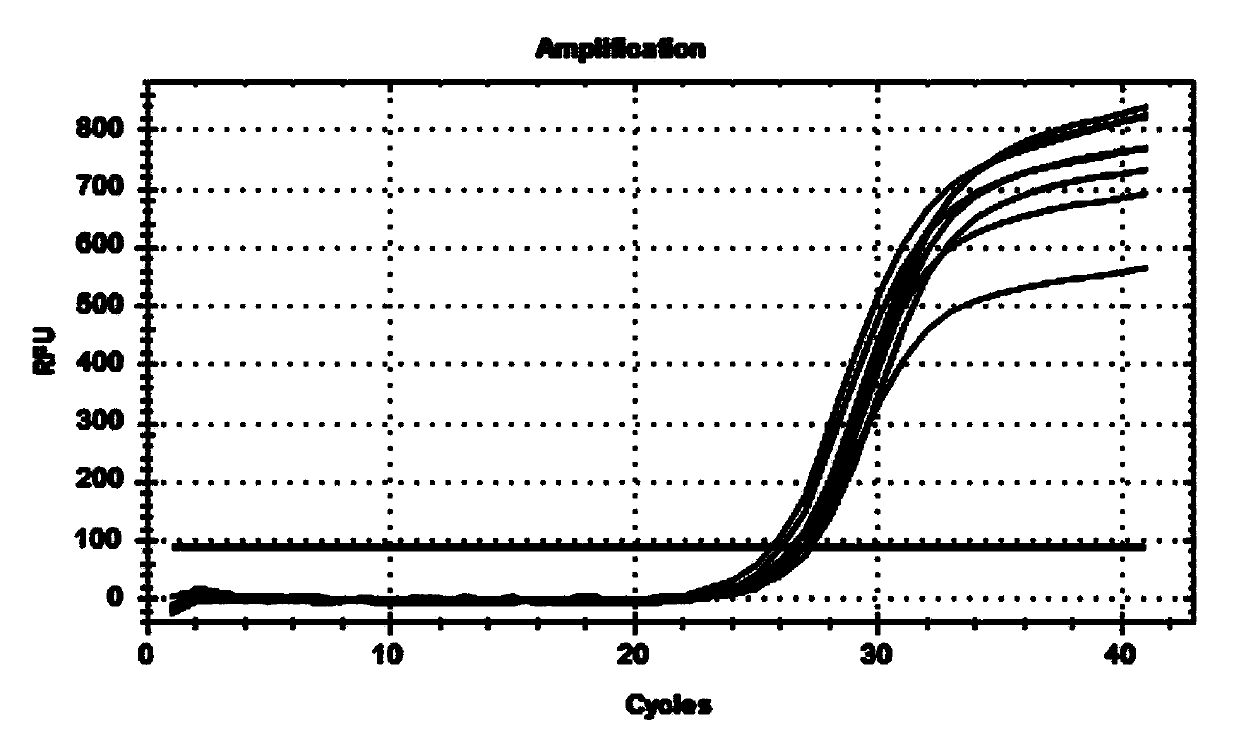TaqMan fluorescent quantitative PCR method for identifying pork components by utilizing CACA gene and application thereof
A technology for pork and purpose, applied in the field of molecular biology, can solve problems such as being unsuitable for quantitative detection, and achieve the effect of improving trust, avoiding pollution and strong specificity
- Summary
- Abstract
- Description
- Claims
- Application Information
AI Technical Summary
Problems solved by technology
Method used
Image
Examples
Embodiment 1D
[0043] Example 1DNA Extraction and Amplification Experiment
[0044] 1. Experimental materials
[0045] 1.1 Animal material
[0046] Eight different breeds of pigs (Sus scrofa) (Enshi black pig (male), Enshi black pig (female), Enshi native pig, Huangpi native pig, Shuanghui pork, COFCO pork, wild boar, hybrid wild boar) were used for the experiment. The other 13 different animal materials are: cattle (Bovine), sheep (Caprinae), donkeys (Equus asinus), camels (Camelus bactrianus), chickens (Gallus domesticus), ducks (Anatinae), dogs (Canis lupus familiaris), rats (Muroidea), Fish (Piscium), Squid (Todarodes pacificus), Shrimp (Fenneropenaeuschinensis), Scallop (Patinopectenyessoensis), Goose (Ansercygnoidesorientalis).
[0047] 1.2 Enzymes and Reagents
[0048] Hieff qPCR SYBR Green Master Mix (real-time fluorescent quantitative PCR amplification premix solution) was purchased from Shanghai Yisheng Biotechnology Co., Ltd., the catalog number is 11201ES03.
[0049] Chlorofo...
Embodiment 2
[0085] Example 2 Primer Screening for Specific Amplification of Pig-derived Components
[0086] 1. Experimental materials
[0087] 1.1 Pig genomic DNA
[0088] 1.2 Enzymes and Reagents
[0089] Molecular biology reagents, Hieff qPCR SYBR Green Master Mix (real-time fluorescent quantitative PCR amplification premix solution) were purchased from Shanghai Yisheng Biotechnology Co., Ltd., the catalog number is 11201ES03.
[0090] PCR primers were synthesized by Wuhan Sangon Bioengineering (Shanghai) Co., Ltd.
[0091] 1.3 Experimental Instruments
[0092] Real-time fluorescence quantitative PCR instrument: CFX Connect (BIO-RAD);
[0093] Ultra-micro-volume ultraviolet spectrophotometer: NanoPhotometer-N80 (Implen);
[0094] Other instruments include: constant temperature water bath, centrifuge, vortex instrument, ultrapure water instrument, etc.
[0095] 2. Experimental method
[0096] 2.1 Design of primers
[0097] Using the pig-specific gene (GenBank accession number XM_...
Embodiment 3
[0107] Example 3 Analysis of Intraspecific and Interspecific Characteristics of Primers CACAF21-CACAR162-CACAP69 for Specific Amplification of Porcine Components
[0108] 1. Experimental materials
[0109] 8 different breeds of pigs (Sus scrofa) (wild boar, hybrid wild boar, Enshi black pig (male), Enshi black pig (female), Enshi native pig, Huangpi native pig, Shuanghui pork, COFCO pork). The other 18 different animal and plant materials are: cattle (Bovine), sheep (Caprinae), donkeys (Equus asinus), camels (Camelus bactrianus), chickens (Gallus domesticus), ducks (Anatinae), dogs (Canis lupus familiaris), Rat (Muroidea), Fish (Piscium), Squid (Todarodes pacificus), Shrimp (Fenneropenaeus chinensis), Scallop (Patinopectenyessoensis), Goose (Anser cygnoides orientalis), Soybean (Glycine max), Sesame (Sesamumindicum), Corn (Zea mays) , Arabidopsis thaliana, Nicotiana tabacum.
[0110] 2. Experimental method
[0111] 2.1. Extraction of plant genomic DNA
[0112] Plant genomi...
PUM
 Login to View More
Login to View More Abstract
Description
Claims
Application Information
 Login to View More
Login to View More - R&D
- Intellectual Property
- Life Sciences
- Materials
- Tech Scout
- Unparalleled Data Quality
- Higher Quality Content
- 60% Fewer Hallucinations
Browse by: Latest US Patents, China's latest patents, Technical Efficacy Thesaurus, Application Domain, Technology Topic, Popular Technical Reports.
© 2025 PatSnap. All rights reserved.Legal|Privacy policy|Modern Slavery Act Transparency Statement|Sitemap|About US| Contact US: help@patsnap.com



